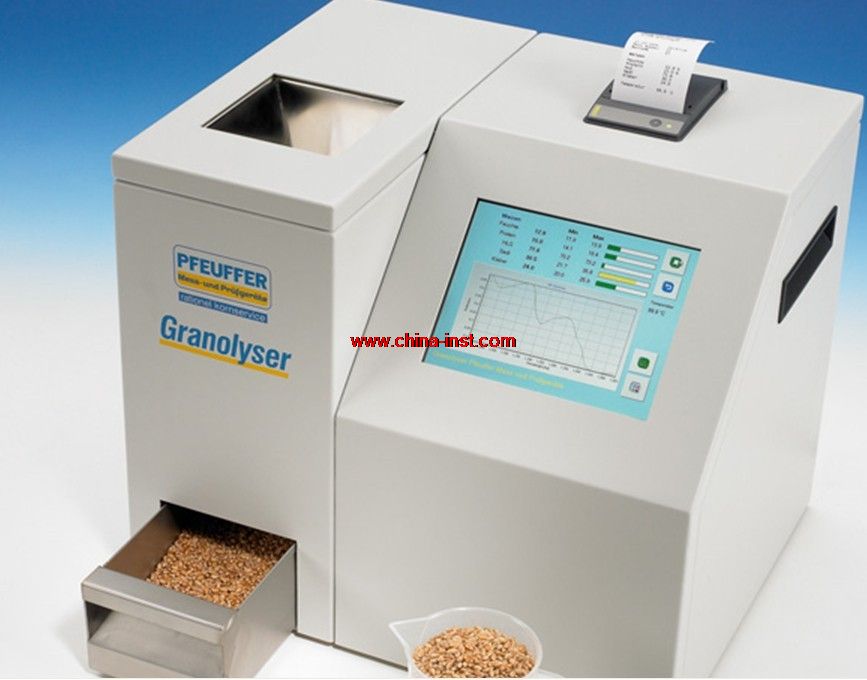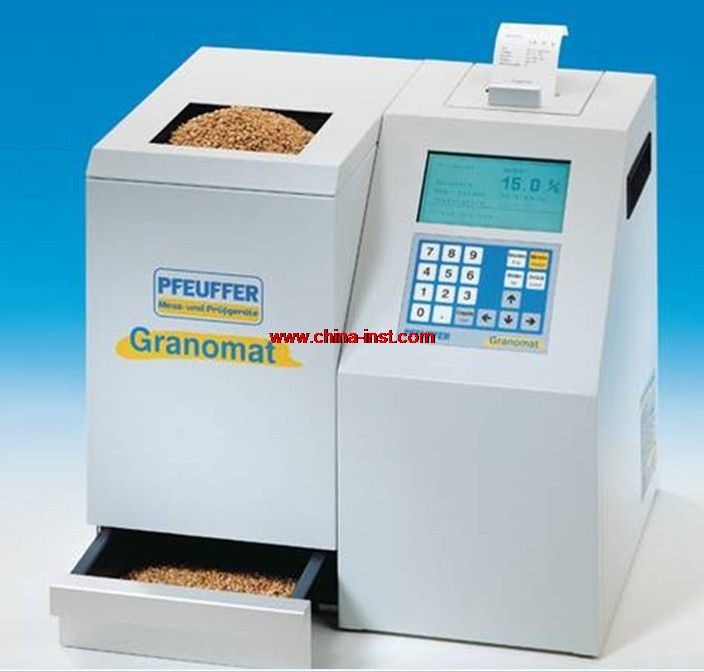|
Analysis of phenolic substances
- simple operation
- comprehensive data
- fast results
Analysis of phenolic substances in beer, wort, extracts of malt and hops, wine, fruit juice and vegetable extracts.Tannometer
Nephelometer with thermostatically controlled measurement chamber and dosing unit.
What is measured?
The Tannometer is suitable for testing most clear liquids and those which contain phenols such as beer, wort, extract of brewing barley, malt and hops, grape and apple wine, fruit juices and vegetable extracts.
The comprehensive analysis allows statements regarding good and poor characteristics like sediment formation, colour intensification and taste changes for routine controls.
The operation is menue controlled. The automatic modes support the analysis of tannoid content, protein sensitivity, reducing capacity, chill haze and ammoniumsulfate titration limit.
Function and Principle
The Tannometer combines a dosing device, temperature control, magnetic stirrer, turbidimeter, photometer and evaluation computer with plotter.
The measurement chamber has a focused light of constant intensity directed through it. The thermostatically controlled sample absorbs and scatters this light. Whilst the first sensor measures this light at a wavelength of 510 nm the second sensor measues scattered light at an angle of 90°.
Operation
An automatic mode is chosen. The sample (approx. 4 ml) is put into a glass cuvette in the measurement chamber. The dosing unit injects agents with high precision into the sample. The homogenization of the sample and the agent is carried out by a magnetic stirrer. The sample can be brought to a temperature between -10°C and +60°C in the thermostatically controlled measurement chamber. Haze and transmission light will be measured and shown on the display.
The micro processor calculates the curves of the parameters and calculates the result. The integrated 4-colour-plotter documents the curves and results. The operation and documentation of the Tannometer can also be carried out by the PC-software TannoLab.? Analysis of beer
The following descriptions concerning the automatic modes relate to the analysis of beer. They are written with the help of Prof. em. Lucien Chapon. There are, however, analogue relations to other solutions.
The equilibrium PT - Key to quality
The concept according to which an equilibrium occurs between proteins (P) and tannoids (T) P+T=PT allows us to understand that a wort and the corresponding beer cannot simultaneously be rich in proteins and tannoids.
The control of these two classes of components gives the brewer precise information about the quality of the raw materials malt and hops. The maltster uses the Tannometer for the purchase of his barley and the control of his production. At the different stages of beer production, rapid analytical methods give the possibility, to follow the dissolving of tannoids, the precipitation of the proteins and the efficiency of stabilisation treatment aimed either at the tannoids or at the proteins. This is a very simple way for optimising the amount of stabilising agent needed.
Tannoids
The tannoids are defined as the fraction of polyphenolic compounds which can be precipitated by polyvinylpyrrolidon (PVP). They include the low and medium molecular polyphenols, the polymers of catechin and anthocyanogens. Tannoids come from the malt and hops. Although present at relatively low concentration, they play an important part in the colloidal and taste stability of beers. On the one hand they can precipitate the sensitive proteins of the wort and beer, on the other hand they act as protective agents. The tannoid content of beer, wort, barley, malt and hop extracts can be determined by precipitation with PVP.
This polymer which can be considered as a structural analog of proteins binds with tannoids by hydrogen bonding to give an insoluble complex which leads to the formation of a haze.
On continous injection of a solution of PVP into the sample a haze develops until all the tannoids are bound. Beyond this point an excess of PVP brings about a progressive dissolution of the haze.
The amount of PVP necessary to reach the maximum is proportional to the tannoid content of the sample. The Tannometer measures the amount of haze formed versus the amount of PVP injected and expresses the result in mg PVP/litre. The curve and the result are printed by the inbuilt plotter.
(literature: Der Begriff Tannoide, Monatsschrift für Brauwissenschaft, No. 7/8 93, page 263-279)
Sensitive proteins
During the lagering of beers their tannoids condense into true tannins. They are then capable of binding themselves with certain proteins to give associations of low solubility. Such a process corresponds to the first step towards the formation of permanent hazes. It proceeds at a very low speed, even at 40°C or 60°C, for strongly stabilised beers. To simulate the spontaneous increase of the true tannin concentration a solution of gallic tannin is injected into the beer. The substances which are protein like in nature and with the strongest affinity with the tannin are insolubilised first. They are known as “sensitive proteins”.
(literature: Der Begriff Eiweißempfindlichkeit, Monatsschrift für Brauwissenschaft, part 1 to 3, No. 9/10 95,
1/2 96, 3/4 96)
Reducing power (capacity)
Beer contains important oxidisable components. The oxidation of some of them impairs the colloidal stability of the beverages as well as its organoleptic quality. The initial freshness gives way to an oxidised taste. Such a beer, impaired by the oxygen in the air, loses its appeal to the consumer.
Malt and hops give the beer protective substances endowed with reducing capacity. They are mainly phenolic in nature, and of low molecular weight, but also include melanoidins formed during the kilning process of the malt and the boiling of the wort. They are able to slow down, if not prevent, oxidation harmful to the quality.
Since beers are exposed to adverse conditions during transportation and storage which can affect their original quality, knowledge of their reducing capacity is of great interest.
Direct determination of the reducing power is not possible on account of the sluggish reactivity of the molecular oxygen. Nevertheless it is possible to take advantage of the reactivity of the ferric dipyridyle complex (DPFe3, according to Chapon) or that of the 2.6. Dichlorphenolindophenol (DPI, according to Hartong) toward the above reducing substances to determine the buffer-capacity of malt or hop extracts and that of beers.
Practical experience has proved that the taste stability of beers with a large reducing capacity was generally good. However there is no reference value which could be taken into account when predicting the actual behaviour towards oxygen.
Chill Haze - Alcohol-Chilling-Test (ACT)
A beer sample cooled down below freezing point (downto -8°C) develops a chill haze dependent on its condition. This haze is caused by insolubility of polyphenol-protein complexes. The test carried out immediately after filtration or bottling gives accurate information regarding the potential haze of the beer and the efficency of the stabilisation treatment which can be adapted if required.
During distribution and storage the ACT gives information regarding haze forming condensation phenomena leading to an increase in tannin power against haze sensitive proteins. This phenomenon, during which the molecular weight of the tannoids increases, is caused mainly by oxidation to which beers poor in reducing components are especially sensitive.
The addition of ethanol decreases the solubility of the PT-complex and enhances the chill haze. In the ACT one can add upto 6% vol. ethanol. The addition of 1% vol. alcohol has the same effect as lowering the temperature 1°C. The Tannometer measures the chill haze as a function of temperature and time. The result expresses the haze formed in EBC units after a preset time (40 minutes).
Ammonium Sulphate titration limit (Hartong)
This rapid analytical method gives information about the hydrophilie character of the colloidal constituents of beer. The addition of ammonium sulphate to beer induces a haze formation.
The greater the amount necessary to achieve a given haze value the higher the chances of stability. The limit of precipitation is expressed as the volume of saturated ammonium sulphate solution which induces the beginning of the haze formation. There is however no linear relationship between the precipitation limit and the colloidal stability, since it depends not only on the proteins but also on other factors such as tannin and oxygen content.? Conclusion
The analysis encompasses both tannoids and proteins. Both are particularly important for the chemical-physical stability.
Additionally, reducing substances which buffer the damaging dissolved oxygen can be determined. Likewise the Alcohol chill haze test, which allows fast determination of the total turbidity building substances, is of significant value.
Simple operation
The sample preparation is very easy. Basically the sample must be clear and free of gas bubbles.
For beer it is enough to pass the sample through a standard laboratory fan folded filter paper.
Fast results
Within a maximum of 3 hours you have the complete picture concerning the chemical-physical stability of your beer. This means you know the stability of the beer before it leaves the brewery.
Optimisation of the brewing process
Many factors in the brewing process can have an influence on the various components making up the tannins and proteins. A thorough knowledge of these factors is critical for the optimisation of the brewing process with regard to the required composition and stability of the beer. It is therefore possible to maintain low tannoid contents from the outset and in doing so reduce the amount of subsequent stabilisation required.
TannoLab PC software
The serial interface opens new perspectives. The PC operates the complete measurement, the curves will be plotted online on the screen. Curves and results can be saved for later evaluations on the integrated database TannoBase. The export of data to standard-software, like MS Excel, is also included.
specifications
voltage: 230/240V/50/60 Hz
dimensions: H205, L500, W305mm
temp.range: from -10°C to +60°C
environ. temp.: from 15°C to 30°C
dosing speed: from 0,5 to 5,0 ml/h
stirrer: Teflon-coated magnetic stirrer
keyboard: acid and water resistant foil keyboard
display: LCD, illuminated, 2 x 40 characters
interface: serial, RS 232C MS Windows-software
|














 MSN客服
MSN客服
